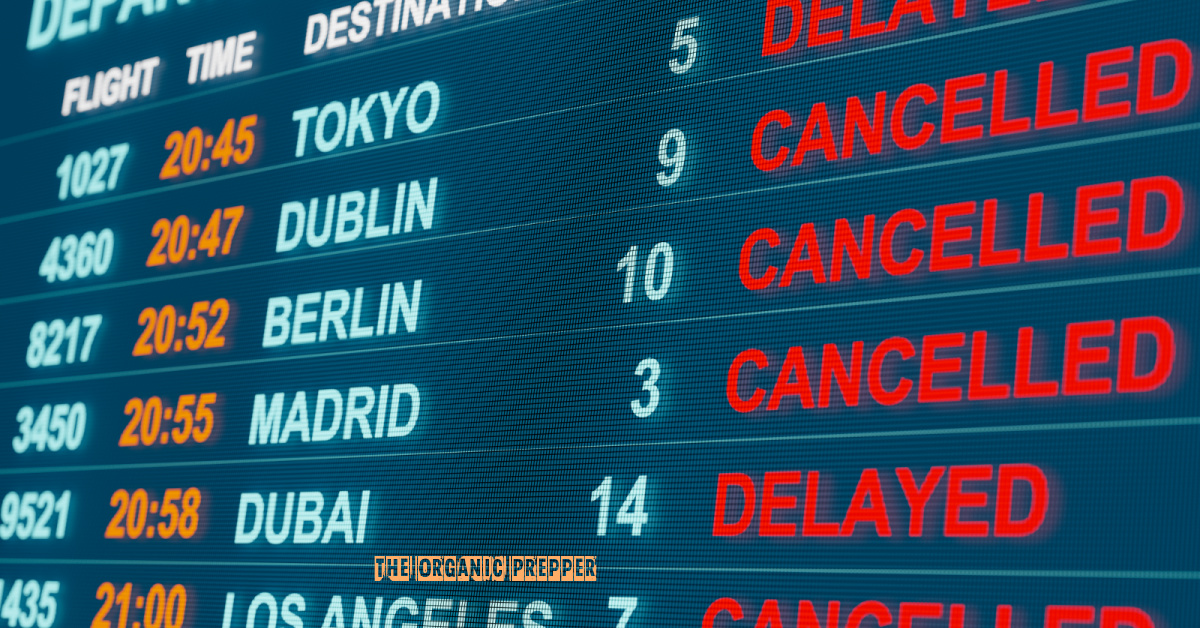(Psst: The FTC wants me to remind you that this website contains affiliate links. That means if you make a purchase from a link you click on, I might receive a small commission. This does not increase the price you’ll pay for that item nor does it decrease the awesomeness of the item. ~ Daisy)
Moving where you want in pursuit of career opportunities and adventure has been part of the American psyche for a long time. My family has been like that for decades, with the end result that we are now really, really scattered. We still like each other; we often travel to see each other for the holidays thanks to air travel. My dad has been traveling for work for a long time and has always been generous with frequent flyer miles to any family member tight on cash. The airlines have made a lot of money from my extended family.
Until now.
Sure, everyone’s getting slammed by inflation. But that’s only part of it. Even if we could afford the tickets themselves, none of us can afford the uncertainty that comes with frequent delays. And delays seem to be getting worse all the time.
Is air travel measurably worse?
Is this just due to a lack of balance between supply and demand, as people want to fly more but airlines struggle to re-hire all those folks laid off during lockdowns? Might there be other forces at work that want to make air travel miserable?
I know we all have lots of horrible anecdotes, but let’s look at some data.
Lending Tree posted a table of historic delay and cancellation rates over the past ten years. In 2014, 21.99% of flights were delayed. That percentage dropped below 20% in 2015, and stayed between 15 and 19% through 2019. In 2020 and 2021, delayed flights fell below 11%, though those two years were flukes because of the lockdown-induced collapse in demand.
In 2022, though, delayed flights were back up to nearly 20%, and this year 21.60% of flights have been delayed so far.
But why is air travel so messed up?
There is not one thing that explains all the misery. Some folks are blaming climate change. But a more compelling reason is the severe labor shortage. In 20 out of 26 critical control traffic towers, staffing is well below the FAA’s required 85% threshold. Airlines are short 17,000 pilots, 12,800 certified mechanics, and 3000 air traffic controllers.
The average salary for an airline pilot is $120,615 per year. The average salary for an aircraft mechanic, whose training program is only about 24 months, is $67,840. The average salary for an air traffic controller is $94,260.
These are decent jobs. How come nobody wants them?
Maybe some of it is health-related.
Maybe it’s harder to find people that can physically do them. Pilots have to meet certain health standards to be cleared to fly, and then must undergo periodic health checks to make sure they stay in shape. They are required to retire at age 65, though there is talk of increasing that to 67 because of the shortage
The insistence on physical fitness is reasonable. An older woman managing a store won’t kill all the customers if she has a heart attack at work. The pilot might.
However, in October 2022, the FAA quietly amended the allowable electrocardiogram (EKG) range for pilots. They widened it to a point where it can accommodate pilots with cardiac injuries, something that had never been allowable before.
Maybe the FAA hoped no one would notice, but we’re a year past that change now, and the damage is becoming obvious. Professional Australian pilot Captain Shane Murdock wrote a report just this past week that emergency calls have been skyrocketing the past few years. Pilots have a variety of codes they issue in emergencies, but code 7700 is the one used for severe distress, such as a health emergency or a fire in the cabin.
These calls are all tracked, and in 2018 and 2019, an average of 29.125 severe distress signals occurred each month. In 2022, there was an average of 108.33 monthly distress calls. In the first quarter of 2023, an average of 141.67 monthly distress calls were recorded. Something happened between 2019 and 2022 that has made sudden health emergencies on planes far more common these days. But you can draw your own conclusions.
And naturally, mid-flight health emergencies lead to unplanned landings and delays. One unplanned landing will typically have a cascading effect on many other flights. And so the misery spreads.
Air traffic controllers are exhausted.
In-flight health emergencies aren’t the only thing making flying more nerve-wracking these days. 2023 has seen the most near-miss collisions on runways in decades. Making sure planes navigate safely through runways is the responsibility of air traffic controllers, but for some reason, they don’t seem to be able to do their jobs anymore.
Part of this is overwork. No one performs optimally when they’re exhausted. Part of it is also that in 2014, the FAA ditched the test it had been using for decades for one aimed at making air traffic controllers more diverse. The FAA, under the Obama administration, prioritized “off the street” hiring over graduates of certified air traffic controller schools. These graduates sued and won, and in 2018, Trump got rid of the new test that had been used to enable less-qualified candidates to enter the program.
But the damage was done. The hiring and career path pipeline for the newer generation of air traffic controllers was severely damaged during the Obama administration, and now, as older controllers age out, we are seeing a massive shortage.
Then there’s the lack of privacy.
Fliers are losing their luggage at higher rates, too. SITA, which handles IT issues for most airlines, admits that the industry has problems that need addressing. Their solution? Increased biometric data collection.
The push toward collecting biometric data for travel purposes began with mandating biometric data for entry into the US after 9/11, when Americans were understandably hyper-concerned about security.
But it wasn’t just traumatized Americans behind this. In 2013, the World Economic Forum wrote a report about emerging strategies for biometric data collection, and on page 7, they discuss shifting consumer attitudes from being aware of their own privacy to placing more value on innovation and economic growth.
They want us to drop our principled privacy concerns for the sake of convenience.
And as travel became more part of professional life, dropping privacy concerns for the sake of speediness through airports really became necessary. Misery in air travel has made travelers far more willing than they used to be to hand over their biometric information. For example, in 2019 only 46% percent of passengers were willing to share their biometric data in order to make things move more smoothly. By 2021, that number had leapt to 73%.
Facial recognition is optional for now. We wrote about this years back when Atlanta rolled it out. Customers who are truly uncomfortable storing their biometric data can still opt out. However, according the head of the TSA, opting out will no longer be an option in a few more years. If you are not comfortable using your face as a boarding pass, you will not be able to fly.
Countries like China, India, and Iran already have extensive biometric data collection in place. Americans and Europeans have been historically far more reluctant to hand over data, but the time may be coming when we have to choose between handing over our information and flying at all.
It might seem strange that airlines are seemingly so unconcerned about alienating customers, but airlines don’t run the world. There are other, more powerful groups, that openly want to change air travel from something many families regularly utilize to spend time together, to a rare, heavily regulated occurrence.
We’ve talked about C40 on this website before. In 2019, they issued a report in which they stated that by 2030, their progressive goal is for people to enjoy one short-haul flight every two years. Their ambitious goal is to allow one short haul flight every three years. Many are eager to link a person’s alleged climate damage to their passports to disallow trips.
I guess military families with members stationed all over the world just aren’t supposed to see each other anymore. No more long haul flights for anyone, ever.
Either agree or stop traveling. Either one is just what they want.
Air travel is getting pushed in a direction where it’s so miserable that people are either willing to hand over any data requested for the sake of less hassle or they just decide not to fly. Both choices adhere to often cited goals of groups like C40.
Inflation has made my decision for me. I’ve only flown twice in the past four years, though one of those was a long-haul flight because I’m closer to one coast and my parents are closer to the other. How selfish of me to see my parents once every few years! I don’t see myself taking any more plane trips any time soon. But I am grateful that I have many good friends in my community. I may not be with any blood relations this Thanksgiving weekend, but I won’t be alone.
Developing trusted local networks is something we bring up a lot on this website. If you can still fly around to see loved ones, that’s wonderful. For those of us who can’t, there has never been a better time to nurture our local connections.
What about you?
Do you fly regularly? Have you noticed it becoming more inconvenient and unpleasant? What do you think the reasons are? Alternatively, have you made the decision to stop flying? What was the thing that caused you to make that choice?
Let’s discuss it in the comments section.
About Marie Hawthorne
A lover of novels and cultivator of superb apple pie recipes, Marie spends her free time writing about the world around her.

















